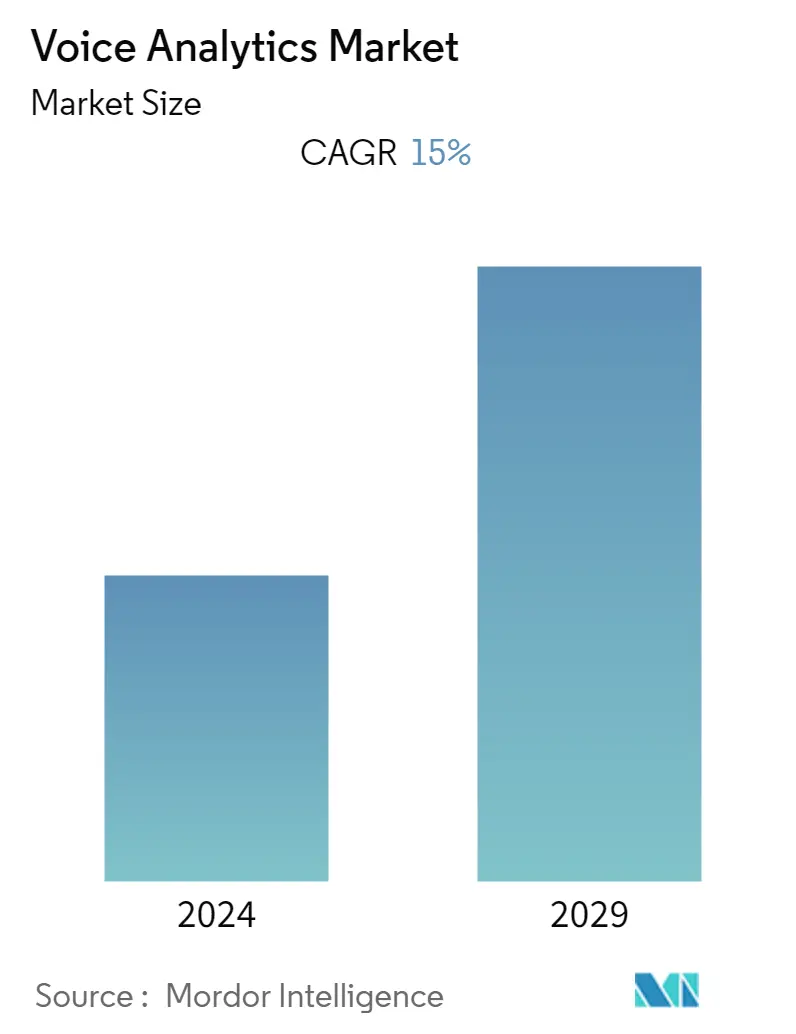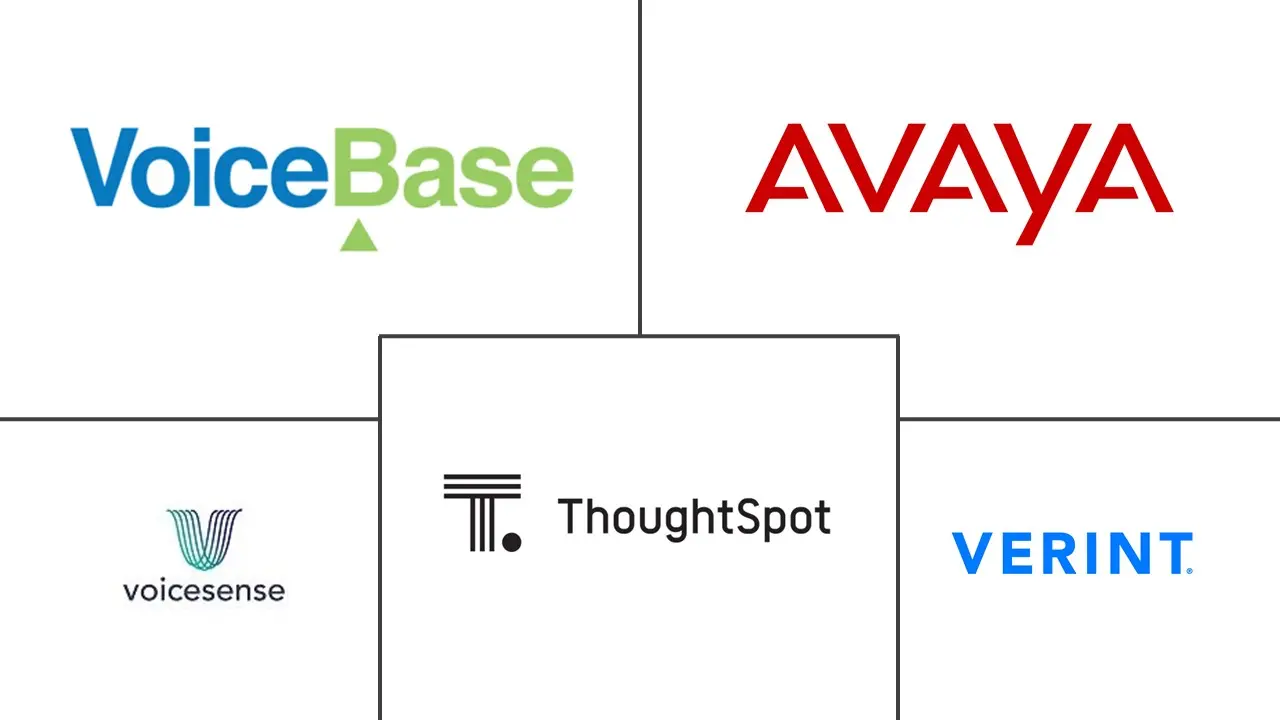Market Size of Voice Analytics Industry

| Study Period | 2019 - 2029 |
| Base Year For Estimation | 2023 |
| CAGR | 15.00 % |
| Fastest Growing Market | Asia Pacific |
| Largest Market | North America |
| Market Concentration | Medium |
Major Players
*Disclaimer: Major Players sorted in no particular order |
Voice Analytics Market Analysis
The Voice Analytics Market is expected to register a CAGR of 15% over the forecast period. Voice analytics is one such branch of analytics that enables organizations to leverage data to analyze spoken words. It is regarded as one of the fastest-growing technologies due to its sentiment analyses, among other things, which amidst the conversation, help organizations such as retail to understand users' inclination towards a product or service in real-time.
- With the expansion of the internet and the different technical applications that support it, it is becoming increasingly difficult for companies to evaluate the massive volume of data in order to gain some significant insight. Many analytical approaches and tools have been developed throughout the years by organizations to examine and get business insights from data.
- The most extensively used use of voice analytics is in call centers, where it delivers relevant information by leveraging both structured and unstructured interactions between employees and callers. Other probable applications include bioacoustics, mental healthcare, banking and finance markets, and so on.
- Furthermore, unlike speech analytics, which just analyzes what is spoken but not how it is spoken, voice analytics might be used to monitor audio voice notes by analyzing audio patterns for vocal features such as syllable pitch, tempo, tone, and rhythm. For example, in a customer care situation, voice analytics would be able to detect profanity, incorrect language, and pitch, and the algorithm would route the call to a supervisor if such anomalies were detected.
- As with the healthcare sector, voice analytics is used to monitor patients with depression and another mental health issues. For instance, According to the World Health Organization, in 2021, more than 280 million people worldwide will suffer from depression. This is attracting many vendors to invest in the voice analytics market to cater to the growing opportunity in the healthcare industry.
- Furthermore, in April 2022, Instreamatic introduced Speaky, the voice AI platform for quick customer communication and real-time sentiment analysis. With the help of this, customers can rapidly and easily communicate themselves to brands or content creators by leaving brief audio messages at any physical or digital brand touchpoint with the new many-to-one communication solution.
- Owing to these instances, many organizations across industries are considering deploying voice analytics leveraging data sources such as recorded data, social media data, and other syndicate data to understand its users. Also, there's been a trend with the demand for an on-premise solution as companies deal with complex IT structures that require integrated solutions such as marketing, CRM, and sales support, among others which allows them to mitigate compatibility issues, however with the added scalability and flexibility of cloud solutions would leverage the growth of cloud deployments.
- During the pandemic, the demand for voice analytics in sales and marketing improved customer service drives the market growth. The adoption of new technologies and the transition of enterprises to the online mode stimulates companies to implement communication analytics solutions. The trend continues, the voice analysis usage increased and further helped to target the right customers based on their reviews and feedback about their previous purchases.
Voice Analytics Industry Segmentation
Voice analytics refers to the application of voice recognition tools to analyze and record spoken conversations. Unlike speech analytics that focuses on phonetic pronunciations to pick out individual words, it analyses the vocal elements such as tone, pitch, syllable emphasis, and tempo to classify the speaker's behavior into emotions such as sadness, anger, fear, and happiness among other upon running it against emotional voice database leveraging the vocal data.
This report is segmented by Component (Solution, Service), Deployment (Cloud, On-premise), Organization Size (SMEs, Large Enterprise), Application (Health Monitoring, Sentiment Analysis, Sales & Marketing, Risk & Fraud Detection, and Call monitoring), End-user Vertical ( Retail & E-commerce, Telecom, BFSI, Healthcare, Government & Defence and Other), and Geography.
The market sizes and forecasts are provided in terms of value in USD million for all the above segments.
| Component | |
| Solution | |
| Services |
| Deployment | |
| Cloud | |
| On-premise |
| Organization Size | |
| Small and Medium-sized Enterprises | |
| Large Enterprises |
| Application | |
| Health Monitoring | |
| Sentiment Analysis | |
| Sales & Marketing | |
| Risk & Fraud Detection | |
| Call monitoring |
| End-user Vertical | |
| Retail & E-commerce | |
| Telecom & IT | |
| BFSI | |
| Healthcare | |
| Government & Defence | |
| Other End-user Verticals |
| Geography | ||||||
| ||||||
| ||||||
| ||||||
| ||||||
|
Voice Analytics Market Size Summary
The voice analytics market is experiencing rapid growth, driven by its ability to analyze spoken words and derive insights through sentiment analysis. This technology is increasingly being adopted across various sectors, including retail, healthcare, and finance, to understand customer preferences and improve service delivery. Voice analytics differs from traditional speech analytics by not only interpreting the content of conversations but also analyzing vocal features such as pitch, tempo, and tone. This capability is particularly valuable in applications like call centers, where it can enhance customer interactions by identifying issues such as profanity or incorrect language usage. The market is further bolstered by advancements in AI and machine learning, which are being integrated into voice analytics solutions to provide deeper insights and predictive capabilities.
North America holds a significant share of the voice analytics market, supported by increased digital marketing investments and a focus on mental health. The region's agencies, including the CIA, are investing in technologies that leverage voice analytics for security and intelligence purposes. Additionally, the healthcare sector is seeing a rise in the use of voice analytics for monitoring mental health conditions, attracting investments from various vendors. The financial industry is also exploring voice analytics to detect fraud through verbal and non-verbal cue analysis. The market's growth is further fueled by strategic collaborations and product innovations, as companies strive to enhance their offerings and expand their market presence.
Voice Analytics Market Size - Table of Contents
-
1. MARKET DYNAMICS
-
1.1 Market Overview
-
1.2 Market Drivers
-
1.3 Market Restraints
-
1.4 Value Chain Analysis
-
1.5 Porter's Five Forces Analysis
-
1.5.1 Threat of New Entrants
-
1.5.2 Bargaining Power of Buyers/Consumers
-
1.5.3 Bargaining Power of Suppliers
-
1.5.4 Threat of Substitute Products
-
1.5.5 Intensity of Competitive Rivalry
-
-
1.6 Assesment of the Impact of COVID-19 on the Industry
-
-
2. MARKET SEGMENTATION
-
2.1 Component
-
2.1.1 Solution
-
2.1.2 Services
-
-
2.2 Deployment
-
2.2.1 Cloud
-
2.2.2 On-premise
-
-
2.3 Organization Size
-
2.3.1 Small and Medium-sized Enterprises
-
2.3.2 Large Enterprises
-
-
2.4 Application
-
2.4.1 Health Monitoring
-
2.4.2 Sentiment Analysis
-
2.4.3 Sales & Marketing
-
2.4.4 Risk & Fraud Detection
-
2.4.5 Call monitoring
-
-
2.5 End-user Vertical
-
2.5.1 Retail & E-commerce
-
2.5.2 Telecom & IT
-
2.5.3 BFSI
-
2.5.4 Healthcare
-
2.5.5 Government & Defence
-
2.5.6 Other End-user Verticals
-
-
2.6 Geography
-
2.6.1 North America
-
2.6.1.1 United States
-
2.6.1.2 Canada
-
-
2.6.2 Europe
-
2.6.2.1 Germany
-
2.6.2.2 United Kingdom
-
2.6.2.3 France
-
2.6.2.4 Rest of Europe
-
-
2.6.3 Asia-Pacific
-
2.6.3.1 India
-
2.6.3.2 China
-
2.6.3.3 Japan
-
2.6.3.4 Rest of Asia-Pacific
-
-
2.6.4 Latin America
-
2.6.4.1 Brazil
-
2.6.4.2 Argentina
-
2.6.4.3 Rest of Latin America
-
-
2.6.5 Middle East and Africa
-
2.6.5.1 United Arab Emirates
-
2.6.5.2 Saudi Arabia
-
2.6.5.3 Rest of Middle East and Africa
-
-
-
Voice Analytics Market Size FAQs
What is the current Voice Analytics Market size?
The Voice Analytics Market is projected to register a CAGR of 15% during the forecast period (2024-2029)
Who are the key players in Voice Analytics Market?
ThoughtSpot, Inc., Verint Systems, VoiceSense Ltd, Avaya and VoiceBase, Inc. are the major companies operating in the Voice Analytics Market.

